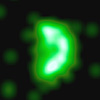Venus In A New Light
This Chandra image, the first X-ray image ever made of Venus, shows a half crescent due to the relative orientation of the Sun, Earth and Venus. The X-rays from Venus are produced by fluorescent radiation from oxygen and other atoms in the atmosphere between 120 and 140 kilometers above the surface of the planet. In contrast, the optical light from Venus is caused by the reflection from clouds 50 to 70 kilometers above the surface.
Solar X-rays bombard the atmosphere of Venus, knock electrons out of the inner parts of atoms, and excite the atoms to a higher energy level. The atoms almost immediately return to their lower energy state with the emission of a fluorescent X-ray. A similar process involving ultraviolet light produces the visible light from fluorescent lamps.
This and future X-ray images will enable scientists to examine regions of the Venusian atmosphere that are difficult to investigate otherwise.
|
||||||||||||||||||||||||||





